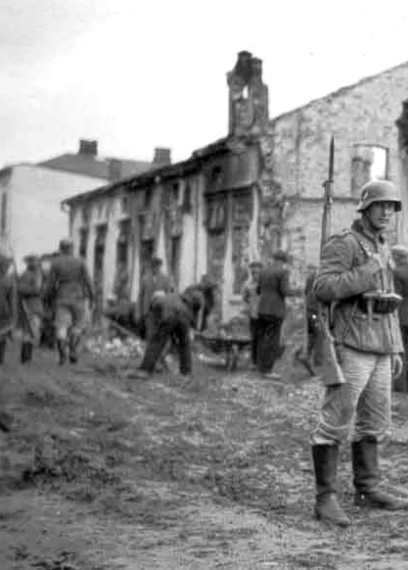Elevation 349 m (1,145 ft) Population 8,426 (2013) | Founded 1455 Area 8.5 km² Local time Saturday 8:04 AM Team FC Rava Rava-Ruska | |
 | ||
Weather 0°C, Wind SW at 6 km/h, 88% Humidity | ||
Rava-Ruska (Ukrainian: Рава-Руська, translit. Rava-Rus'ka; Polish: Rawa Ruska; Yiddish: ראווע, Rave) is a city in Zhovkva Raion, Lviv Oblast of western Ukraine. It is a border town between Ukraine and Poland. The border checkpoint is situated 8 km (5 mi) west of the city, along the international autoroute Warsaw - Lviv. Population: 8,426 (2013 est.).
Contents
- Map of Rava Ruska Lvivska Ukraine
- History
- 20th century
- World War II and the Holocaust
- After World War II
- Transportation
- Rail station
- Points of interest
- Notable people
- References
Map of Rava-Rus'ka, Lvivska, Ukraine
History
Rawa-Ruska was founded in 1455 by the Polish prince Władysław I of Płock, Duke of Bełz and Mazovia, who named the settlement after his regional seat, Rawa Mazowiecka located further west. Due to a convenient location along the merchant trail from Lublin to Lwów, the newly located town quickly developed. For centuries, Rawa was part of the Kingdom of Poland and the Polish-Lithuanian Commonwealth. It remained in private hands of several consecutive szlachta families, such as the Głogowski, Suchodolski, Rzeczycki and Bogusz. In 1622, the town received permission of the King of Poland to organize fairs. In 1672, a skirmish between Polish and Crimean Tatar forces took place here, in which Polish unit under Atanazy Miaczynski freed hundreds of captured peasants. In 1698, Rawa was the site of a meeting between Peter the Great and Augustus the Strong, which led to the Treaty of Preobrazhenskoye in 1699.
From the first partition of Poland in 1772 until the end of World War I in 1918, the town was part of the Austrian Partition ruled first by the Austrian Empire and then by Austria-Hungary after the compromise of 1867. It was a seat of the Rawa Ruska district, one of the 78 Bezirkshauptmannschaften in Austrian Galicia province (Crown land) in 1900. In 1880, its population was 10,500, with 37% Jews, 35% Poles, 20% Germans and 7% Ukrainians. In 1857, Rawa received a rail connection with Jarosław, and next year, the railroad reached Sokal.
20th century
In the early 20th century, Rava-Ruska developed into a rail junction, with a connection to Lviv and Rejowiec, built in 1915. After the rebirth of Poland Rawa-Ruska became part of the Lwów Voivodeship, and the seat of the Powiat Rawski county (area 1,401 km2 (541 sq mi)). The line from to Rejowiec was of main importance, as it connected two main cities of Poland, Warsaw, and Lwów. Due to the rail lines, Rawa prospered, and several businesses operated in the town. In 1924, a Belgian company opened here a factory of railroad ties. Furthermore, in the interbellum period Rawa was home to Main School of the Border Guard, which was moved here in 1928 from Góra Kalwaria. The school had a department of training of guard dogs, also located in Rawa-Ruska.
According to Polish census of 1921, the population of the town was approximately 9,000; with 42% Poles, 42% Jews and 14% Ukrainians. By 1938, the population increased to 12,000.
World War II and the Holocaust
On 14 September 1939, during the Invasion of Poland, Rawa-Ruska was captured by the Wehrmacht. The German troops left the town within days in accordance with the German-Soviet Frontier Treaty, and Rava-Ruska was occupied by the Soviet forces. A year and a half later, it was again recaptured by the Germans on the 28 June 1941 during the German attack on the Soviet positions in eastern Poland which marked the beginning of Operation Barbarossa. The Ukrainian People's Militia was formed. The town was incorporated into the General Government territory. The Judenrat was established in July 1941. In March 1942 the nearby Bełżec extermination camp began its killing operations, and at the end of the month the first Holocaust train with 1,000 Jews left Rawa Ruska for Bełżec. Many Jewish residents were killed at Belzec in further deportations. Approximately 5,000 Polish Jews from Rava-Ruska were shot during a liquidation "Aktion" between 7 and 11 December 1942. The last execution of Jews occurred in June 1943, during which 300-400 Jews were executed in a forest outside the village.
After World War II
After World War II, the Polish community of Rava-Ruska was forced to abandon the town and move to the Recovered Territories. Nevertheless, Rava-Ruska remains one of the key centres of the Polish minority in Ukraine, with the local office of the Association of Polish Culture of the Lviv Land operating here.
Transportation
It is located near the border with Poland, opposite the town of Hrebenne. Through the city passes the European route . At the border there is a checkpoint "Rava-Ruska".
Rail station
The city has a railroad station which also has a border and customs checkpoint "Rava-Ruska". Since 2005 it has been used exclusively for freight transportation only and has two directions, one towards Hrebenne, another towards Werchrata.
